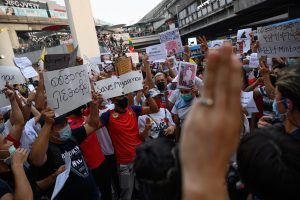Hundreds of thousands have poured into the streets across Myanmar for a planned nationwide strike, defying the military’s thinly veiled threats of violent crackdown to demand that the new junta release of State Counselor Aung San Suu Kyi and recognize her party’s landslide win at elections in November.
The strike, which brought cities across the country to a standstill today, was shaping up as the largest shows of mass public discontent in the three weeks since the military’s February 1 coup. As of early afternoon, evidence was trickling through social media of a series of large gatherings across the span of the country.
Tens of thousands massed in Yangon, the country’s largest city, including more than a thousand at at the U.S. Embassy, where 20 military trucks with riot police had arrived nearby. Other large groups were reported in cities including Mandalay, Monywa, Pathein, Taungoo, and Naypyidaw.
While the campaign of anti-coup protests, strikes, and disruptions show no sign of dying down, today’s nationwide strike began in an atmosphere of tension and trepidation. On Sunday evening, the state broadcaster MRTV carried a public announcement from the junta, officially known as the State Administration Council, warning against the general strike and threatening the use of lethal force.
“It is found that the protesters have raised their incitement towards riot and anarchy mob on the day of 22 February,” it said. “Protesters are now inciting the people, especially emotional teenagers and youths, to a confrontation path where they will suffer the loss of life.” The junta’s statement also blamed criminals for past protest violence, with the result that “the security force members had to fire back.”
The junta’s announcement was lent force by the killing of two more protesters on Saturday, when police and soldiers fired on demonstrators in the central city of Mandalay, the bloodiest day so far in the post-coup protests.
According to a report by Reuters, tensions were sparked when police and soldiers confronted striking shipyard workers in quarters of the city lying along the Irrawaddy River. Some of the demonstrators fired catapults at police as they were chased through the back streets.
A doctor who witnessed Saturday’s protests in Mandalay told Al Jazeera that the scenes resembled a “war zone,” in which police deployed were beating protesters, drenching them with water cannon, and firing on them with live rounds, rubber bullets, and slingshots. One man died from a head wound, according to witnesses, while another was shot in the chest and died later of his injury. He was identified by relatives as Thet Naing Win, a 36-year-old carpenter.
The shootings in Myanmar are reported to have been committed by the military’s 33rd Light Infantry Division, whose involvement in well-documented involvement in massacres and other atrocities committed against the Rohingya in western Myanmar has been well documented. In August 2018, the U.S. government imposed sanctions on the entire 33rd division and several of its key commanders. Tom Andrews, the U.N. Special Rapporteur on Myanmar, described the deployment of the 33rd division as “a dangerous escalation by the junta in what appears to be a war against the people of Myanmar.”
The killings came a day after the death in hospital of Mya Thwe Thwe Khine, who was shot in the head during a protest in the capital Naypyidaw on February 9, two days before her 20th birthday, and had remained in critical condition. Since then, the young woman has evolved into a martyr for the anti-coup movement, with protesters waving banners featuring her portrait. Her funeral in Naypyidaw on Sunday reportedly drew a crowd of tens of thousands.
By its own sanguinary standards, the Myanmar military’s response to the escalating street protests has been relatively restrained. Soldiers and police have deployed water cannon, rubber bullets, air guns, slingshots, and batons in order to disperse protesters, and so far shied away from the widespread use of live ammunition. This has led some analysts to suggest that a large-scale violent crackdown is unlikely, and that the military, recognizing that time is on its side, has adopted a more patient strategy to deal with the protests.
In truth, it is probably hard to say for sure what will happen, especially if the protests continue on their current trajectory. In both 1988 and 2007, brutal crackdowns came after weeks of protests and simmering tensions, and the country is still at the beginning of what could be a protracted political crisis. Given the Tatmadaw’s bloody track record, it is unfortunately impossible to rule anything out.

































